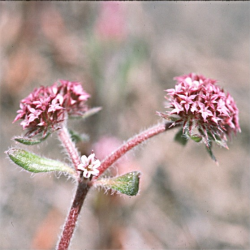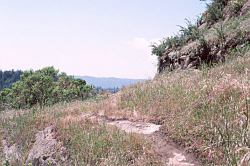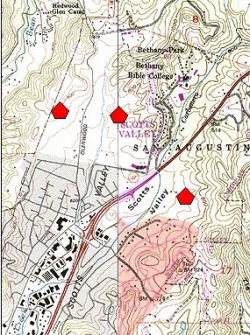
endangered

Photo taken on Cupcake Hill on the Glenwood property in Scotts Valley by Dean W. Taylor.

Photo taken on Cupcake Hill on the Glenwood property in Scotts Valley by Dean W. Taylor.

A red polygon indicates an extant occurrence.



This fact sheet was prepared by Dylan M. Neubauer and Dean W. Taylor under award NA04N0S4200074 from the National Oceanic and Atmospheric Administration (NOAA), U.S. Department of Commerce (DOC). The statements, findings, conclusions, and recommendations are those of the authors and do not necessarily reflect the views of the NOAA or the DOC.
© Copyright 2006, Elkhorn Slough Coastal Training Program
Last updated: Sep 6, 2007 21:52
Common Names - Scotts Valley spineflower
Family - Polygonaceae (Buckwheat Family)
State Status - none
Federal Status - federal endangered
(February 1994)
Habitat
Margins of barren or bryophyte dominated patches of Purisima Formation sandstone or Santa Cruz Mudstone outcrops in coastal prairie, but only where competing vegetation is reduced by shallow soils; 200–300 m.
Key Characteristics
Annual herb, erect, 1–3 dm tall, hairy; leaves in basal rosette and at lowest few nodes, oblanceolate, blades 1–5 cm long, 2–7 mm wide; inflorescence dense, cymose; bracts 2, awns 0; involucre 3-angled, 6-ribbed, tube 2.5–3.5 mm long, teeth 6, 0.3–1 mm, margins rose-pink, awns 0.7–1.3 mm, hooked; flower 1, 2.5–4 mm, hairy, perianth 2-colored, tube white, lobes white to rose, generally jagged or toothed; stamens 9 (Reveal and Rosatti 2013). Based on growth habit and involucre teeth margin color, could be easily confused with Ben Lomond spineflower (C. pungens var. hartwegiana).
Flowering Period
April to July
Reference Population
Scotts Valley High School easement (Santa Cruz County).
Global Distribution
Endemic to the central coast of California in Santa Cruz County.
Conservation
A 2009 genetic study of the Pungentes subsection of Chorizanthe (Brinegar and Baron) illustrates that the inland-growing Scotts Valley spineflower is more closely related to the inland-growing Ben Lomond spineflower (C. pungens var. hartwegiana) than to the coastal-growing robust spineflower (C. robusta var. robusta). And, the robust spineflower is more closely related to the coastal-growing Monterey spineflower (C. pungens var. pungens) than to the Scotts Valley spineflower. The current Jepson Manual/eFlora treatment (Reveal 2013) does not reflect this information.
Highly endangered from the actual and potential threat of development within all known habitat; a significant area of high-quality occupied habitat was destroyed by construction of a high school in 1999. The City of Scotts Valley’s policies and posture during the 1990s proved ineffective at conserving this species. A management and monitoring plan for the Glenwood occurrence is available (Wetland Research Associates 2003), where populations have numbered on the order of 10,000 plants. The Polo Ranch occurrence numbered ca. 8,000 plants in 1997. Virtually sympatric with all known habitat for Scotts Valley polygonum (Polygonum hickmanii), also endangered.
References
Abrams, L. 1944. Illustrated Flora of the Pacific States, Vol. 2. Stanford University Press, Palo Alto, CA.
Brinegar, C. and S. Baron. 2009. Molecular phylogeny of the Pungentes subsection of Chorizanthe (Polyognaceae: Eriogonoideae) with emphasis on the phylogeography of the C. pungens–C. robusta complex. Madroño 56(3):168–183.
CNPS, Rare Plant Program. 2015. Chorizanthe robusta var. hartwegii in Inventory of Rare and Endangered Plants (online edition, v8-02). California Native Plant Society, Sacramento, CA. http://www.rareplants.cnps.org/detail/1627.html [accessed 3 February 2015].
Ertter, B. 1996. Saga of the Santa Cruz spineflower. Fremontia 24(4):8-11.
Reveal J. L. and T. J. Rosatti. 2013. Chorizanthe robusta var. hartwegii, in Jepson Flora Project (eds.). Jepson eFlora, http://ucjeps.berkeley.edu/cgi-bin/get_IJM.pl?tid=56503 [accessed 3 February 2015].
U.S. Fish and Wildlife Service (USFWS). 2009. Chorizanthe robusta var. hartwegii (Scotts Valley spineflower) 5-year review: summary and evaluation. Ventura Fish and Wildlife Office, Ventura, CA. https://ecos.fws.gov/docs/five_year_review/doc4028.pdf [accessed 3 February 2015].
Wetland Research Associates. 2003. Glenwood Open Space Management Plan.
